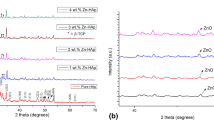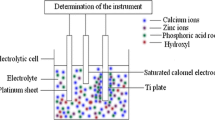Abstract
Large surface charges can be induced on hydroxyapatite (HAp) ceramics by proton transport polarization, but this does not affect β-tricalcium phosphate (TCP) because of its low polarizability. We wished to examine differences in osteogenic cell activity and new bone growth between positively or negatively surface-charged HAp and HAp/TCP plates using a calvarial bone defect model. In the first group of rats, test pieces were placed with their positively charged surfaces face down on the dura mater. In the second group, test pieces were placed with their negatively charged surfaces face down on the dura mater. A third group received noncharged test pieces. Histological examination, including enzymatic staining for osteoblasts and osteoclasts, was carried out. While no bone formation was observed at the pericranium, direct bone formation on the cranial bone debris and new bone growth expanded from the margins of the sites of injury to bridge across both the positively and negatively charged surfaces of HAp and HAp/TCP plates occurred. Electrical polarization of implanted plates, including positive charge, led to enhanced osteoblast activity, though decreased osteoclast activity was seen on the positively charged plate surface. Thus, polarization of HAp ceramics may modulate new bone formation and resorption.










Similar content being viewed by others
References
Ricci JL, Blumenthal NC, Spivak JM, Alexander H (1992) Evaluation of a low temperature calcium phosphate particulate implant material: physical chemical properties and in vivo bone response. J Oral Maxillofac Surg 50: 969–978
Hoogendoorn HA, Renooij W, Akkermans LM, Visser W, Wittebol P (1984) Long-term study of large ceramic implants (porous hydroxyapatite) in dog femora. Clin Orthop 187: 281–288
Klein CPAT, de Blieck-Hogervorst JMA, Wolke JGC, de Groot K (1990) Studies of the solubility of different calcium phosphate ceramic particles in vitro. Biomaterials 11: 509–512
Koerten HK, van der Meulen J (1999) Degradation of calcium phosphate ceramics. J Biomed Mater Res 44: 78–86
Fujita R, Yokoyama A, Kawasaki T, Kohgo T (2003) Bone augmentation using with calcium phosphate ceramics: experiment using hydroxyapatite and β-tricalcium phosphate plates. Oral Maxillofac Surg 61: 1045–1053
Miyake H, Ohta T, Tanaka H (2000) A new technique for cranioplasty with L-shaped titanium plates and combination ceramic implants composed of hydroxyapatite and tricalcium phosphate (Ceratite). Neurosurgery 46: 414–418
Somasundaran P, Wang YHC (1984) Surface chemical characteristic and absorption properties of apatite: a review. In: Misra DE (ed), Adsorption on and surface chemistry of hydroxyapatite. Plenum Press, New York, pp 129–149
Kiniwa S, Ono T, Takeshita N, Nagai N (1986) Englobement mechanism of macrophage, relationship to surface charge of synthetic hydroxyapatite. Jpn J Oral Biol 28: 215
Shirasuga N, Awai M, Tatsuno K, Nakago T, Ishida O, Nagai N (1988) Ultrastructural studies of osteogenic and phagocytic cell kinetics on the bone-hydroxyapatite interface. J Jpn Orthod Soc 47: 536–548
Nakamura S, Takeda H, Yamashita K (2001) Proton transport polarization and depolarization of hydroxyapatite ceramics. J Appl Physiol 89: 5386–5392
Kobayashi T, Nakamura S, Yamashita K (2001) Enhanced osteobonding by negative surface charges of electrically polarized hydroxyapatite. J Biomed Mater Res 57: 477–484
Nakamura S, Kobayashi T, Yamashita K (2002) Extended bioactivity in the proximity of hydroxyapatite ceramic surfaces induced by polarization charges. J Biomed Mater Res 61: 593–599
Yamashita K, Kitagaki K, Umegaki T (1995) Thermal instability and proton conductivity of ceramic hydroxyapatite at high temperature. J Am Ceram Soc 78: 1191–1197
Yamashita K, Owada H, Umegaki T, Kanazawa T, Futagami T (1988) Ionic conduction in apatite solid solutions. Solid State Ionics 28–30: 660–663
Yamashita K, Owada H, Umegaki T, Kanazawa T, Katayama K (1990) Protonic conduction in yttrium-substituted hydroxyapatite ceramics and their applicability to H2-O2 fuel cell. Solid State Ionics 40–41: 918–921
Owada H, Yamashita K, Kanazawa T (1991) High-temperature stability of hydroxyl ions in yttrium-substituted oxyhydroxyapatites. J Mater Sci Lett 9: 26–28
Ueshima M, Nakamura S, Yamashita K (2002) Huge millicoulomb charge storage in ceramic hydroxyapatite by bimodal electric polarization. Adv Mater 14: 591–595
Yamashita K, Oikawa N, Umegaki T (1996) Acceleration and deceleration of bone-like crystal growth on ceramic hydroxyapatite by electric poling. Chem Mater 8: 2697–2700
Ueshima M, Nakamura S, Ohgaki M, Yamashita K (2002) Electrovectorial effect of polarized hydroxyapatite on quasi–epitaxial growth at nanointerfaces. Solid State Ionics 151: 29–34
Nakamura S, Kobayashi T, Yamashita K (2004) Numerical osteobonding evaluation of electrically polarized hydroxyapatite ceramics. J Biomed Mater Res A 68: 90–94
Li RH, Wozney JM (2001) Delivering on the promise of bone morphogenetic proteins. Trends Biotechnol 19: 255–265
Deans RJ, Moseley AB (2000) Mesenchymal stem cells - biology and potential clinical uses. Exp Hematol 28: 875–884
Lerner UH (2000) Osteoclast formation and resorption. Matrix Biol 19: 107–120
Acknowledgement
We thank Dr. Wei Wang (Department of Plastic Surgery, Tokyo Medical and Dental University) for surgical assistance, Mr. Toshiyuki Ishii (Department of Inorganic Materials, Institute of Biomaterials and Bioengineering, Tokyo Medical and Dental University) for preparing the polarized HAp ceramics, and Ms. Hanae Abe for histological analysis.
Author information
Authors and Affiliations
Corresponding authors
Rights and permissions
About this article
Cite this article
Itoh, S., Nakamura, S., Kobayashi, T. et al. Effect of Electrical Polarization of Hydroxyapatite Ceramics on New Bone Formation. Calcif Tissue Int 78, 133–142 (2006). https://doi.org/10.1007/s00223-005-0213-6
Received:
Accepted:
Published:
Issue Date:
DOI: https://doi.org/10.1007/s00223-005-0213-6




